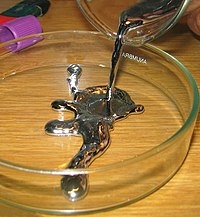
Investigation of carbonaceous materials electrosorption attributes and its performance for capacitive deionization process within the presence of humic acid
Sign Up to like & getrecommendations! Published in 2021 at "Environmental Science and Pollution Research"
DOI: 10.1007/s11356-021-15542-6
Abstract: This present investigation emphasizes on pros and cons of humic acid (HA) on electrosorption behaviour and performance efficiency of capacitive deionization (CDI) process. Electrosorptive removal of HA was examined by lab scale CDI flow cell… read more here.
Keywords: carbon; capacitive deionization; investigation; performance ... See more keywords

Electrosorption of uranium(VI) by highly porous phosphate-functionalized graphene hydrogel
Sign Up to like & getrecommendations! Published in 2019 at "Applied Surface Science"
DOI: 10.1016/j.apsusc.2019.04.103
Abstract: Abstract In the present work, we reported the preparation of a highly porous phosphate-functionalized graphene (HGP) hydrogel electrode material by a two-step process for uranium (U(VI)) electrosorption. The extra pores were pre-created on graphene nanosheets… read more here.
Keywords: phosphate; electrosorption; graphene; highly porous ... See more keywords

Nanostructuring of pseudocapacitive MnFe2O4/Porous rGO electrodes in capacitive deionization
Sign Up to like & getrecommendations! Published in 2019 at "Electrochimica Acta"
DOI: 10.1016/j.electacta.2019.03.097
Abstract: Abstract Capacitive deionization (CDI) has been used to remove salt ions with carbon electrodes by the electrical double layer (EDL) mechanism. Other non-carbon materials based on pseudocapacitive mechanism resulting from faradaic reactions with fast electrosorption/desorption… read more here.
Keywords: electrosorption; mnfe2o4 porous; capacitive deionization; rgo ... See more keywords

Enhanced electrosorption selectivity of phosphate using an anion-exchange resin-coated activated carbon electrode.
Sign Up to like & getrecommendations! Published in 2021 at "Journal of colloid and interface science"
DOI: 10.1016/j.jcis.2021.04.129
Abstract: Regenerable methods for phosphate (P) recycling have received intense attention due to their potential environmental and economic benefits. In this study, to improve the electrosorptive removal of P in membrane capacitive deionization, an activated carbon… read more here.
Keywords: anion exchange; exchange resin; carbon electrode; electrode ... See more keywords

Rapid selective removal of thorium via electrosorption towards efficiently managing rare-earth extraction residue
Sign Up to like & getrecommendations! Published in 2021 at "Journal of environmental chemical engineering"
DOI: 10.1016/j.jece.2021.105478
Abstract: Abstract In this present study, thorium ion [Th(SO4)32-] was removed from aqueous sulphate medium using fabricated activated carbon-based electrodes (CBE). The thermal cross-linking technique was used to synthesize the CBE. Fourier transform infrared spectroscopy (FTIR),… read more here.
Keywords: electrosorption; selective removal; spectroscopy; adsorption ... See more keywords

Electrosorption of phenolic compounds from olive mill wastewater: Mass transport consideration under a transient regime through an alginate-activated carbon fixed-bed electrode.
Sign Up to like & getrecommendations! Published in 2022 at "Journal of hazardous materials"
DOI: 10.1016/j.jhazmat.2022.128480
Abstract: Olive mill wastewater (OMWW) is an environmentally critical effluent, specifically due to its high content of phenolic compounds (PCs), which are hazardous due to their antimicrobial activities in water. However, their properties have good health… read more here.
Keywords: mass transport; mill wastewater; electrosorption; olive mill ... See more keywords

Electro-desalination of saline solutions by multiwall carbon nanotube electrodes
Sign Up to like & getrecommendations! Published in 2021 at "Journal of Saudi Chemical Society"
DOI: 10.1016/j.jscs.2021.101328
Abstract: Abstract Electrodes of multiwall carbon nanotube (MWCNT) with polytetrafluoroethylene (PTFE) binding were prepared for NaCl removal from water in the electrosorption system. SEM, XRD and BET analysis were used to characterize the prepared electrodes. The… read more here.
Keywords: electrosorption; electro desalination; carbon nanotube; multiwall carbon ... See more keywords

Capacitive deionization of chloride ions by activated carbon using a three-dimensional electrode reactor
Sign Up to like & getrecommendations! Published in 2018 at "Separation and Purification Technology"
DOI: 10.1016/j.seppur.2017.09.015
Abstract: Abstract A three-dimensional electrode reactor was introduced into capacitive deionization (CDI). Electrosorption kinetic and the thermodynamic parameters on removal of chloride ions from aqueous solutions at various temperatures (298–323 K), anode potentials (0.3–1.2 V), circulation velocities (75–168 mL min… read more here.
Keywords: three dimensional; electrode reactor; chloride ions; dimensional electrode ... See more keywords

A facile synthesis of porous MXene-based freestanding film and its spectacular electrosorption performance for organic dyes
Sign Up to like & getrecommendations! Published in 2021 at "Separation and Purification Technology"
DOI: 10.1016/j.seppur.2021.118365
Abstract: Abstract In this work, we report a facile and scalable approach to synthesis a porous MXene/single-walled carbon nanotubes (p-MXene/SWCNTs) film as a freestanding electrode for the electrosorption of the organic dyes in wastewater. Dye adsorption… read more here.
Keywords: electrosorption; mxene; adsorption; organic dyes ... See more keywords

Eggshell membrane derived nitrogen rich porous carbon for selective electrosorption of nitrate from water.
Sign Up to like & getrecommendations! Published in 2022 at "Water research"
DOI: 10.1016/j.watres.2022.118351
Abstract: Nitrate (NO3-) is a ubiquitous contaminant in water and wastewater. Conventional treatment processes such as adsorption and membrane separation suffer from low selectivity for NO3- removal, causing high energy consumption and adsorbents usage. In this… read more here.
Keywords: electrosorption; eggshell membrane; water; no3 selectivity ... See more keywords

Boron Removal from Reverse Osmosis Permeate Using an Electrosorption Process: Feasibility, Kinetics, and Mechanism.
Sign Up to like & getrecommendations! Published in 2022 at "Environmental science & technology"
DOI: 10.1021/acs.est.2c02297
Abstract: Boron is present in the form of boric acid (B(OH)3 or H3BO3) in seawater, geothermal waters, and some industrial wastewaters but is toxic at elevated concentrations to both plants and humans. Effective removal of boron… read more here.
Keywords: electrosorption; removal; boron; boron removal ... See more keywords